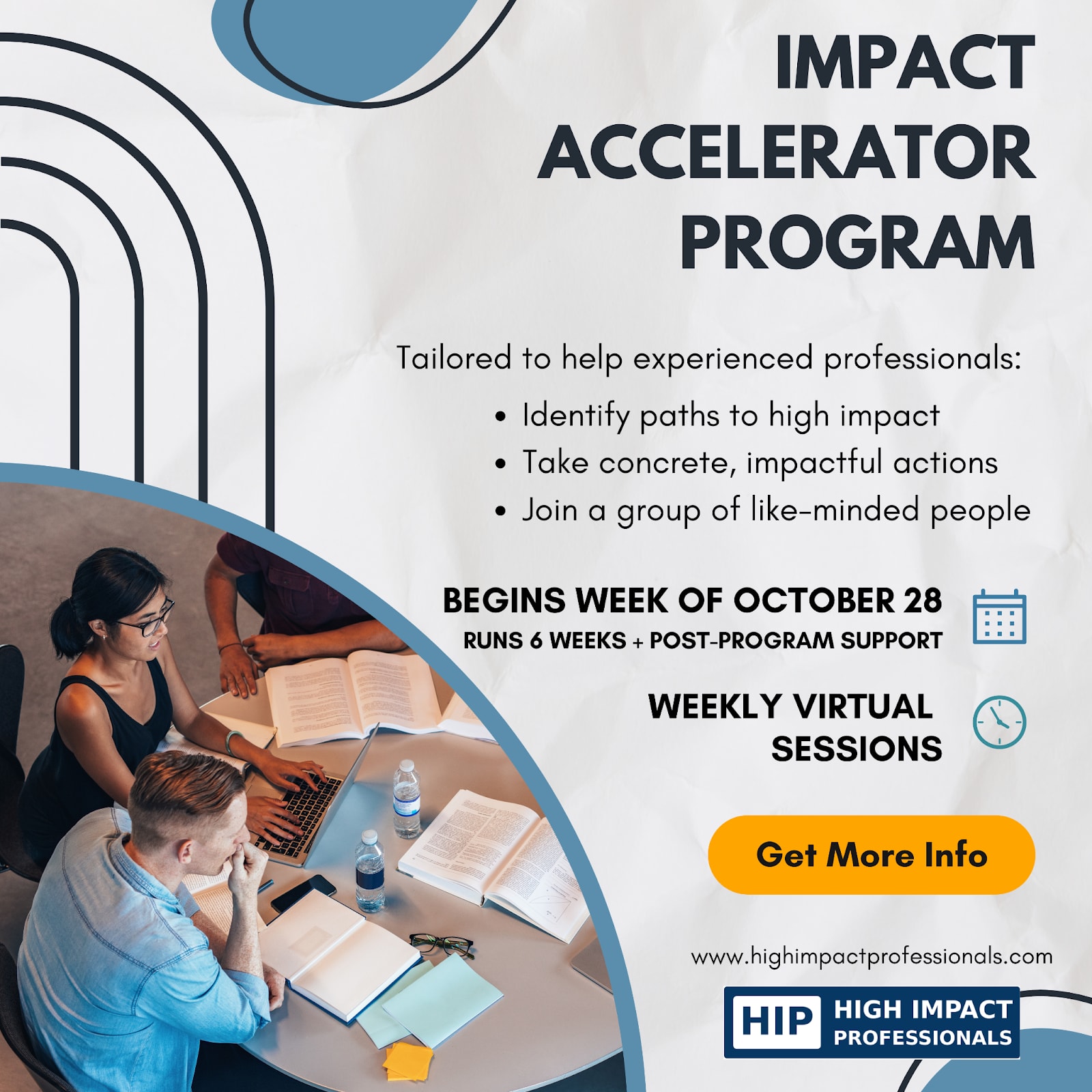High Impact Professionals is excited to announce that applications are now open for the Fall 2024 round of our Impact Accelerator Program (IAP). The IAP is a 6-week program designed to equip experienced (mid-career/senior) EA-aligned professionals (not currently working at a high-impact organization) with the knowledge and tools necessary to make a meaningful impact and empower them to start taking actionable steps right away.
To date, the program’s high action focus has proven to be successful:
- 33% of participants have transitioned into high-impact careers, including joining Charity Entrepreneurship and roles in AI Safety;
- a further 33% are taking concrete actions toward high-impact careers, including volunteering at EA-aligned orgs; and
- many participants are donating a meaningful percentage of their annual salary to effective charities, with several having taken the 🔶 10% Pledge or 🔷 Trial Pledge.
We are currently running the Summer 2024 round, which features the program’s largest number of participants and cohorts.
We’re pleased to open up this new Fall 2024 program round, which will start the week of October 28. More information is available below and here.
Please apply by September 5.
Apply nowProgram Objectives
The IAP is set up to help participants:
- identify paths to impact,
- take concrete, impactful actions, and
- join a network of like-minded, experienced, and supportive impact-focused professionals.
At the end of the program, a participant should have a good answer to the question “How can I have the most impact with my career, and what are my next steps?”, and they should have taken the first steps in that direction.
Program Overview
Important Dates
- Program duration: 6 weeks (week of October 28 – week of December 2, 2024)
- Deadline to apply: September 5
Format
- Weekly individual work (2–3 hours). A mix of:
- Learning: Reading resources on how to think about and prioritize different options for impact
- Doing: Taking impactful actions, such as developing your own personalized impact plan and taking concrete steps to begin implementing it
- Virtual group sessions (1.5 hours of discussions and coaching)
- Includes mastermind sessions where each member of the cohort has the opportunity to present their plans, obstacles, and uncertainties and get in-depth, tailored feedback
- 1-on-1 sessions with IAP facilitators
- Extracurricular sessions: The possibility of extra sessions on topics defined by the needs of the cohort (e.g., financial considerations, networking)
- Post-program support sessions: Access additional group sessions in the months following the program, as well as regular alumni sessions, to maintain momentum and continue implementing your plan
Topics covered
- Values and mission – determine your motivations / guiding principles, strengths, and weaknesses to set a clear starting point for your journey
- Paths to impact for professionals – explore the landscape of career possibilities, address your key uncertainties, and identify your best career and impact options
- Develop an action plan – put all you’ve discovered into a roadmap with actionable steps to guide you to your impact goals
- Implement your plan – Begin taking active steps to turn your plan into an impactful reality
Led by: Select members of the High Impact Professionals team/community
Why Should You Apply?
- Overcome Barriers: We'll guide you in exploring your personal obstacles to impact and assist you in taking real-world, impactful actions.
- Understand Impact: Delve into the complex nature of creating positive change and discover the diverse opportunities available to professionals.
- Develop and Implement a Solid Impact Plan: Acquire tools to assess and plan for impact, and integrate them into your own circumstances to create a personal roadmap for maximizing your positive influence. Then, begin taking concrete steps to put your plan into action.
- Connect with Like-Minded People: Embark on this journey alongside others who share similar goals and aspirations, fostering a supportive community of impact-oriented professionals.
- Get a Boost in Our Talent Directory: If you successfully go through our program, your profile in our Talent Directory will be marked as such, signaling to potential employers that you’ve taken steps toward having more impact.
Who Should Apply?
We're looking for motivated, results-driven, experienced mid-career/senior EA-aligned professionals (not currently working at a high-impact organization) who aspire to maximize their impact and are seeking guidance in navigating the path to achieving it.
You'll likely get the most value from the program if you:
- are a mid-career or senior professional,
- are not currently working at a high-impact organization,
- have contemplated how you can do the most good, and
- haven't yet taken many significant steps in that direction.
Please note that the above are guidelines. Therefore, if you feel you'd benefit from the program but don't think you fit the criteria, please apply anyway!
We look forward to receiving your application and helping you make a lasting difference in the world.
Apply nowQuestions?
If you have any questions or comments, please see the FAQ section of the IAP page and also feel free to reach out to us in the comments or via our website.


That is amazingly high!
Thanks, @Denkenberger! We've been excited by the results we're seeing and are always pushing for that number to go even higher. That success rate is due to some features of the program, including a network of amazing people who push each other to do more and the program's holistic approach to high-impact careers from high-absorbancy paths to more niche selective opportunities.